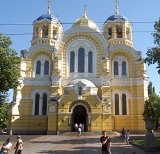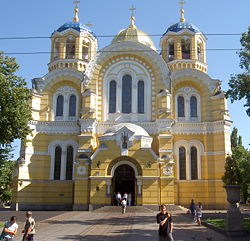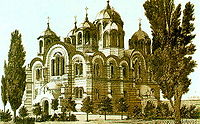
St Volodymyr's Cathedral
Encyclopedia

St Volodymyr's Cathedral is a cathedral
Cathedral
A cathedral is a Christian church that contains the seat of a bishop...
in the centre of Kiev
Kiev
Kiev or Kyiv is the capital and the largest city of Ukraine, located in the north central part of the country on the Dnieper River. The population as of the 2001 census was 2,611,300. However, higher numbers have been cited in the press....
. It is one of the city's major landmarks and the mother cathedral
Mother Church
In Christianity, the term mother church or Mother Church may have one of the following meanings:# The first mission church in an area, or a pioneer cathedral# A basilica or cathedral# The main chapel of a province of a religious order...
of the Ukrainian Orthodox Church - Kiev Patriarchy, one of two major Ukrainian Orthodox Churches
History of Christianity in Ukraine
The History of Christianity in Ukraine dates back to the earliest centuries of the apostolic church. It has remained the dominant religion in the country since its acceptance in 988 by Vladimir the Great , who instated it as the state religion of Kievan Rus', a medieval East Slavic state.Although...
.
History and Description
In 1852, MetropolitanMetropolitan bishop
In Christian churches with episcopal polity, the rank of metropolitan bishop, or simply metropolitan, pertains to the diocesan bishop or archbishop of a metropolis; that is, the chief city of a historical Roman province, ecclesiastical province, or regional capital.Before the establishment of...
Philaret of Moscow suggested a large cathedral should be built in Kiev
Kiev
Kiev or Kyiv is the capital and the largest city of Ukraine, located in the north central part of the country on the Dnieper River. The population as of the 2001 census was 2,611,300. However, higher numbers have been cited in the press....
to commemorate the 900th anniversary of the baptism of Kievan Rus'
Baptism of Kievan Rus'
The Christianization of Kievan Rus took place in several stages. In early 867, Patriarch Photius of Constantinople announced to other Orthodox patriarchs that the Rus', baptised by his bishop, took to Christianity with particular enthusiasm...
by prince Vladimir (Volodymyr) the Great of Kiev
Vladimir I of Kiev
Vladimir Sviatoslavich the Great Old East Slavic: Володимѣръ Свѧтославичь Old Norse as Valdamarr Sveinaldsson, , Vladimir, , Volodymyr, was a grand prince of Kiev, ruler of Kievan Rus' in .Vladimir's father was the prince Sviatoslav of the Rurik dynasty...
(St. Vladimir). People from all over the Russian Empire
Russian Empire
The Russian Empire was a state that existed from 1721 until the Russian Revolution of 1917. It was the successor to the Tsardom of Russia and the predecessor of the Soviet Union...
started donating to this cause, so that by 1859 the cathedral fund had amassed a huge sum of 100,000 rubles
Russian ruble
The ruble or rouble is the currency of the Russian Federation and the two partially recognized republics of Abkhazia and South Ossetia. Formerly, the ruble was also the currency of the Russian Empire and the Soviet Union prior to their breakups. Belarus and Transnistria also use currencies with...
. The Kiev Pechersk Lavra
Kiev Pechersk Lavra
Kiev Pechersk Lavra or Kyiv Pechersk Lavra , also known as the Kiev Monastery of the Caves, is a historic Orthodox Christian monastery which gave its name to one of the city districts where it is located in Kiev, the capital of Ukraine....
(Monastery of the Caves) produced one million bricks and presented them to the cathedral as well. The design was executed in neo-Byzantine style
Neo-Byzantine architecture
The Byzantine Revival was an architectural revival movement, most frequently seen in religious, institutional and public buildings. It emerged in 1840s in Western Europe and peaked in the last quarter of 19th century in the Russian Empire; an isolated Neo-Byzantine school was active in Yugoslavia...
initially by the architects I. Schtrom, P. Sparro, R. Bemhardt, K. Mayevsky, V. Nikolayev. The final version of the design belongs to Alexander Vikentievich Beretti. It is a traditional six-pier
Pier
A pier is a raised structure, including bridge and building supports and walkways, over water, typically supported by widely spread piles or pillars...
ed, three-apse
Apse
In architecture, the apse is a semicircular recess covered with a hemispherical vault or semi-dome...
d temple crowned by seven cupola
Cupola
In architecture, a cupola is a small, most-often dome-like, structure on top of a building. Often used to provide a lookout or to admit light and air, it usually crowns a larger roof or dome....
s. The height to the cross of the main dome is 49 m (161 ft).

Mosaic
Mosaic is the art of creating images with an assemblage of small pieces of colored glass, stone, or other materials. It may be a technique of decorative art, an aspect of interior decoration, or of cultural and spiritual significance as in a cathedral...
s were executed by masters from Venice
Venice
Venice is a city in northern Italy which is renowned for the beauty of its setting, its architecture and its artworks. It is the capital of the Veneto region...
. Fresco
Fresco
Fresco is any of several related mural painting types, executed on plaster on walls or ceilings. The word fresco comes from the Greek word affresca which derives from the Latin word for "fresh". Frescoes first developed in the ancient world and continued to be popular through the Renaissance...
es were created under the guidance of Professor A. Prakhov by a group of famous painters: S. Kostenko, V. Kotarbinsky, Mikhail Nesterov
Mikhail Nesterov
Mikhail Vasilyevich Nesterov was a major representative of religious Symbolism in Russian art. He was a pupil of Pavel Tchistyakov at the Imperial Academy of Arts, but later allied himself with the group of artists known as the Peredvizhniki...
, M. Pymonenko, P. Swedomsky, Viktor Vasnetsov
Viktor Vasnetsov
Viktor Mikhaylovich Vasnetsov , 1848 — Moscow, July 23, 1926) was a Russian artist who specialized in mythological and historical subjects. He was described as co-founder of folklorist/romantic modernism in the Russian painting and a key figure of the revivalist movement in Russian art.- Childhood ...
, Mikhail Vrubel
Mikhail Vrubel
Mikhail Aleksandrovich Vrubel is usually regarded amongst the Russian painters of the Symbolist movement. In reality, he deliberately stood aloof from contemporary art trends, so that the origin of his unusual manner should be sought in Late Byzantine and Early Renaissance painting.-Early...
, V. Zamyraylo, and others. The painting of the Holy Mother of God by Vasnetsov in the altar apse of the cathedral impresses by its austere beauty.
The entrance door is adorned with relief bronze sculptures of St. Olga (Princess Olga of Kiev) by sculptor R. Bakh and St. Vladimir (sculptor H. Zaieman) against a blue background. The iconostasis
Iconostasis
In Eastern Christianity an iconostasis is a wall of icons and religious paintings, separating the nave from the sanctuary in a church. Iconostasis also refers to a portable icon stand that can be placed anywhere within a church...
is carved from the white marble
Marble
Marble is a metamorphic rock composed of recrystallized carbonate minerals, most commonly calcite or dolomite.Geologists use the term "marble" to refer to metamorphosed limestone; however stonemasons use the term more broadly to encompass unmetamorphosed limestone.Marble is commonly used for...
brought from Carrara
Carrara
Carrara is a city and comune in the province of Massa-Carrara , notable for the white or blue-grey marble quarried there. It is on the Carrione River, some west-northwest of Florence....
. The cathedral was completed in 1882, however, the paintings were fully completed only in 1896.
The cathedral risked damage during the Polish-Soviet War
Polish-Soviet War
The Polish–Soviet War was an armed conflict between Soviet Russia and Soviet Ukraine and the Second Polish Republic and the Ukrainian People's Republic—four states in post–World War I Europe...
in 1920. During the Soviet
Soviet Union
The Soviet Union , officially the Union of Soviet Socialist Republics , was a constitutionally socialist state that existed in Eurasia between 1922 and 1991....
period, the cathedral narrowly escaped demolition, but not closure. Until the Second World War it served as a museum of religion and atheism. The relics of St Barbara, a martyr of the 3rd century AD, were transferred to St Volodymyr's from the St. Michael's Golden-Domed Monastery
St. Michael's Golden-Domed Monastery
St. Michael's Golden-Domed Monastery is a functioning monastery in Kiev, the capital of Ukraine. The monastery is located on the right bank of the Dnieper River on the edge of a bluff northeast of the Saint Sophia Cathedral...
before it was destroyed by the Bolshevik
Bolshevik
The Bolsheviks, originally also Bolshevists , derived from bol'shinstvo, "majority") were a faction of the Marxist Russian Social Democratic Labour Party which split apart from the Menshevik faction at the Second Party Congress in 1903....
s , and have remained there since. After the war the cathedral was reopened and since remained continually open. It was then the main church of the Kiev Metropolitan See
Episcopal See
An episcopal see is, in the original sense, the official seat of a bishop. This seat, which is also referred to as the bishop's cathedra, is placed in the bishop's principal church, which is therefore called the bishop's cathedral...
of the Ukrainian Exarchate. The cathedral was one of the few places in the USSR where tourists could openely visit a working Orthodox Church. It saw the revival of Orthodox religion in 1988 when the millennium celebration of the Baptism of Kiev marked a change in Soviet policy on religion.
After the dissolution of the Soviet Union
Dissolution of the Soviet Union
The dissolution of the Soviet Union was the disintegration of the federal political structures and central government of the Union of Soviet Socialist Republics , resulting in the independence of all fifteen republics of the Soviet Union between March 11, 1990 and December 25, 1991...
, St Volodymyr's Cathedral ownership became an issue of controversy
St Volodymyr's Cathedral ownership controversy
The ownership of St Volodymyr's Cathedral is an issue of controversy between two major Orthodox churches in Ukraine: the Ukrainian Orthodox Church and the Ukrainian Orthodox Church - Kiev Patriarchy ....
between two denominations
Christian denomination
A Christian denomination is an identifiable religious body under a common name, structure, and doctrine within Christianity. In the Orthodox tradition, Churches are divided often along ethnic and linguistic lines, into separate churches and traditions. Technically, divisions between one group and...
that both claim to represent Ukrainian Orthodox Christianity
Eastern Orthodox Church
The Orthodox Church, officially called the Orthodox Catholic Church and commonly referred to as the Eastern Orthodox Church, is the second largest Christian denomination in the world, with an estimated 300 million adherents mainly in the countries of Belarus, Bulgaria, Cyprus, Georgia, Greece,...
- the Ukrainian Orthodox Church
Ukrainian Orthodox Church (Moscow Patriarchate)
The Ukrainian Orthodox Church is an autonomous Church of Eastern Orthodoxy in Ukraine, under the ecclesiastic jurisdiction of the Moscow Patriarchate...
, a church with an autonomous status under the Moscow Patriarchy, and the newly established Ukrainian Orthodox Church - Kiev Patriarchy, which, ultimately, won the control over the cathderal.
Spiritual leaders of the Ukrainian Orthodox Church of Kiev Patriarchy continue to conduct religious services and prayers in St. Volodymyr's Cathedral. All the ceremonies are conducted in Ukrainian
Ukrainian language
Ukrainian is a language of the East Slavic subgroup of the Slavic languages. It is the official state language of Ukraine. Written Ukrainian uses a variant of the Cyrillic alphabet....
, accompanied during religious holidays by the Cathedral choir, which is often joined by opera
Opera
Opera is an art form in which singers and musicians perform a dramatic work combining text and musical score, usually in a theatrical setting. Opera incorporates many of the elements of spoken theatre, such as acting, scenery, and costumes and sometimes includes dance...
singers.
External links
- History of Saint Volodymyr Cathedral, Kiev History website Official website Sobory.ru — information about the cathedral
- ukraine-gateway.org.ua — St. Volodymyr's (Volodymyrsky) Cathedral Володимирський собор in Wiki-Encyclopedia Kiev
- ukraine-today.com — St Volodymyr's Cathedral in Kiev
- Houses of Worship in Kiev
- http://www.encyclopediaofukraine.com/display.asp?linkPath=pages\S\A\SaintVolodymyrsCathedral.htm Encyclopedia of Ukraine, St Volodymyr's Cathedral, Kyiv
- St Volodymyr's Cathedral interior panorama

